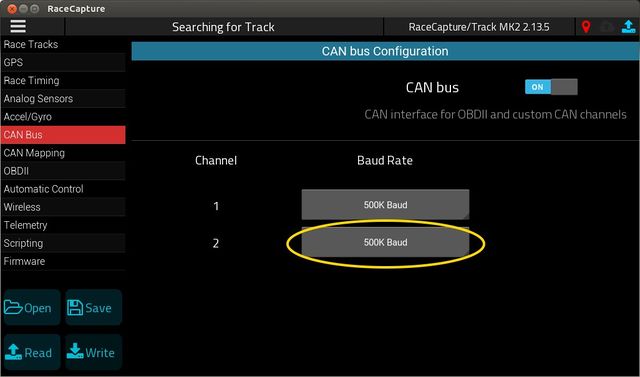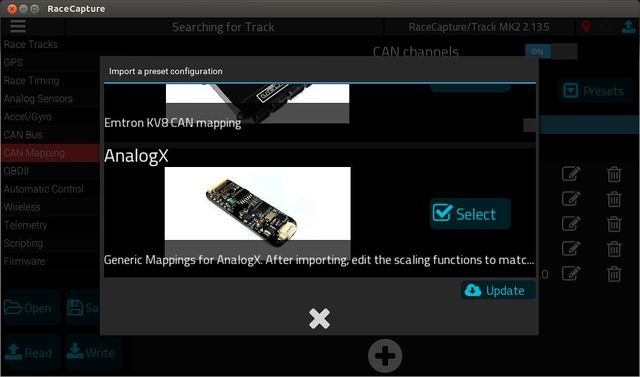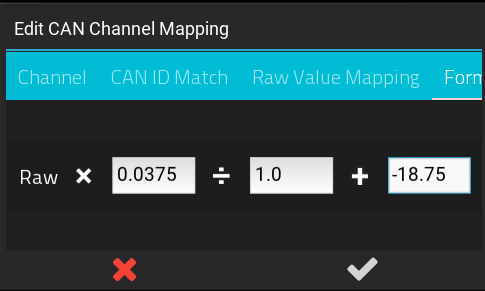AnalogX: Difference between revisions
| Line 26: | Line 26: | ||
* '''Note''' - RaceCapture's CAN mapping features currently only supports sensors with a linear (straight-line) response. Sensors with a curved response, such as thermistors, will not work with the built-in direct CAN mapping. We recommend using a temperature sensor with a linear response, such as the Texense Liquid Temperature Sensor or similar. | * '''Note''' - RaceCapture's CAN mapping features currently only supports sensors with a linear (straight-line) response. Sensors with a curved response, such as thermistors, will not work with the built-in direct CAN mapping. We recommend using a temperature sensor with a linear response, such as the Texense Liquid Temperature Sensor or similar. | ||
===Setting CAN baud rate=== | |||
The default baud rate for AnalogX is 500K. If you still have it set to the default, ensure this is set under Setup / CAN bus settings. | |||
[[file:CAN2_500K_baud.jpg|640px]] | |||
===Selecting the AnalogX preset=== | |||
Select the starter CAN preset for AnalogX. This will bring in the basic 0-5v mapping, which you can then calibrate further using the CAN mapping conversion formula. | |||
[[file:AnalogX_CAN_preset.jpg|640px]] | |||
==Calibrating Sensors attached to AnalogX== | |||
Navigate to Setup / CAN mapping, and edit the channel you wish to customize. | |||
===Select the channel=== | |||
Touch the channel selection drop down and select the channel that matches your sensor. | |||
* '''Note, it's recommended you use the preset name for your channels; if no channel exists that matches your sensor, you can customize the channel name, units, and min/max values directly | |||
[[file:AnalogX_customize_preset.jpg]] | |||
===Edit the conversion formula=== | |||
AnalogX reports it's raw value from 0-5000mV. You can use the formula to scale and offset the raw value to a real-world value. | |||
===Example: 0.5 - 4.5v 150 PSI oil pressure sensor=== | |||
These common sensors have a range with the following mapping: | |||
0.5v = 0 PSI | |||
4.5v = 150 PSI | |||
The sensor has a 4000mV range between 0 PSI and 150 PSI, with a 500mV offset. | |||
Therefore, 150 PSI / 4000mV = 0.0375 PSI/mV, and the resulting formula is RAW * 0.0375 - 18.75 | |||
The offset is calculated based on the 500mV offset of the sensor (500mv * 0.375 = 18.75) | |||
[[file:AnalogX_150PSI_oil_pressure_example_formula.png|640px]] | |||
===AiM, MoTeC and other systems=== | ===AiM, MoTeC and other systems=== | ||
Revision as of 03:01, 9 October 2018
Introduction
AnalogX is a compact and lightweight 4 channel Analog to CAN I/O expander, designed to be installed in-line with your wiring harness and specially designed for the harsh automotive electrical environment.
AnalogX provides 4 buffered and protected 0-5v sensor inputs and can broadcast the sensor values between 1 and 255Hz. It also provides a 0.5A 5v reference for powering sensors.
Parts in the Kit
In the kit you will receive:
- AnalogX module
- 4 wire power and CAN pigtail
- 6 wire analog sensor input pigtail
- 1" shrink tube for installation
Compatible Sensors
AnalogX is compatible with any 0-5v voltage input; the voltage is broadcast over CAN bus to a receiving system.
Use the capabilities provided by the receiving data system to translate the raw voltage to a meaningful real-world value, such as pressure, temperature, distance, and so on.
RaceCapture / PodiumConnect systems
Setting up AnalogX in RaceCapture is easy: Go to Setup / CAN Channels and select the preset for AnalogX.
This will bring in the basic mapping with the default 0-5v scaling. From here, you can edit each channel to customize the formula to match your sensor's voltage scaling.
- Note - RaceCapture's CAN mapping features currently only supports sensors with a linear (straight-line) response. Sensors with a curved response, such as thermistors, will not work with the built-in direct CAN mapping. We recommend using a temperature sensor with a linear response, such as the Texense Liquid Temperature Sensor or similar.
Setting CAN baud rate
The default baud rate for AnalogX is 500K. If you still have it set to the default, ensure this is set under Setup / CAN bus settings.
Selecting the AnalogX preset
Select the starter CAN preset for AnalogX. This will bring in the basic 0-5v mapping, which you can then calibrate further using the CAN mapping conversion formula.
Calibrating Sensors attached to AnalogX
Navigate to Setup / CAN mapping, and edit the channel you wish to customize.
Select the channel
Touch the channel selection drop down and select the channel that matches your sensor.
- Note, it's recommended you use the preset name for your channels; if no channel exists that matches your sensor, you can customize the channel name, units, and min/max values directly
File:AnalogX customize preset.jpg
Edit the conversion formula
AnalogX reports it's raw value from 0-5000mV. You can use the formula to scale and offset the raw value to a real-world value.
Example: 0.5 - 4.5v 150 PSI oil pressure sensor
These common sensors have a range with the following mapping:
0.5v = 0 PSI 4.5v = 150 PSI
The sensor has a 4000mV range between 0 PSI and 150 PSI, with a 500mV offset.
Therefore, 150 PSI / 4000mV = 0.0375 PSI/mV, and the resulting formula is RAW * 0.0375 - 18.75
The offset is calculated based on the 500mV offset of the sensor (500mv * 0.375 = 18.75)
AiM, MoTeC and other systems
Please refer to these manufacturer's user guide on how to map data using the provided AnalogX CAN protocol.
Specifications
| Feature | Description |
|---|---|
| Analog input voltage range | 0 - 5v |
| DAC resolution | 12 bit SAR |
| Sample output format | 0 - 5000mV |
| Input impedance | Greater than 10 Meg Ohm |
| Input voltage protection | 100v |
| Pullup resistor | Optional on-board 2.2K pullup resistor for each channel (jumper enabled) |
| Power input | 9 - 15volts, protected to 40v (intermittent) |
| Weight | 6 grams |
| Dimensions | 0.72" x 1.93" (18.3mm x 48.7mm) |
| CAN baud rate | 500K and 1M, jumper configurable |
| Address Space | 4 separate address spaces allows up to 4 AnalogX modules to operate on the same CAN network. (jumper configurable) |
Source Code
Source code for AnalogX available here: https://github.com/autosportlabs/analogx
Wiring
Power and CAN
| Color | Assignment | Notes |
|---|---|---|
| Red | 9-15v Power | Connect this to switched ignition power. 0.25A max consumption. |
| Black | CAN High | |
| Orange | CAN Low | |
| Blue | Ground |
Sensor connections
| Color | Assignment | Notes |
|---|---|---|
| Brown | Analog 1 input | 0-5v input |
| Pink | Analog 2 input | 0-5v input |
| Purple | Analog 3 input | 0-5v input |
| Blue | Analog 4 input | 0-5v input |
| Yellow | Voltage reference output | 5v @ 0.5A |
| Black | Ground reference |
CAN termination
AnalogX is terminated by default. You can disable termination by carefully scratching the bridge on the CAN TERM pad on the bottom of the AnalogX circuit board.
- Note: Use a razor or very fine tipped screwdriver to break the bridge on the pad, scraping towards the outside of the circuit board. To re-enable the bridge, solder across the pads using a low wattage (15-30W) soldering iron to prevent damage to the pads.
Installation
AnalogX was specifically designed to fit right into your wiring harness for a streamlined, efficient and lightweight installation. Use the included 1" shrink tubing to encase and protect the unit when you are ready to integrate it with your harness.
AnalogX CAN bus API
Overview
The CAN bus API provides the configuration and control interface for AnalogX
CAN base ID
CAN base ID is 0xE4600 (935424)
Adjusting Base ID
The base address is determined by the state of the ADR1 and ADR2 jumpers. By default, the jumpers are closed (bridged); the jumper can be opened by cutting the trace between the pads. To re-close the jumper, add a small amount of solder to bridge the gap between the pads you want to close.
- Opening the jumper ADR1 will add 256 to the base ID
- Opening the jumper ADR2 will add 512 to the base ID.
The combination of jumper settings will allow up to 4 AnalogX units to coexist on the same CAN bus.
| ADR2 Jumper | ADR1 Jumper | Address |
|---|---|---|
| Closed | Closed | 0xE4600 (935424) |
| Closed | Open | 0xE4700 (935680) |
| Open | Closed | 0xE4800 (935936) |
| Open | Open | 0xE4900 (936192) |
CAN Baud rate
500K and 1MB rates are supported.
500K is enabled by default; cut the jumper labeled BAUD on the bottom of AnalogX to enable 1MB rate.
CAN Messages
Announcement
The announcement message is broadcast by the AnalogX upon power up.
Address
CAN ID: Base + 0
| Offset | What | Value |
|---|---|---|
| 0 | Channel Count | Total number of channels on device |
| 1 | Reserved | |
| 2 | Reserved | |
| 3 | Reserved | |
| 4 | Reserved | |
| 5 | Major Version | Firmware Major Version Number |
| 6 | Minor Version | Firmware Minor Version Number |
| 7 | Patch Version | Firmware Patch version number |
Configuration Group 1
Configures options for AnalogX.
Send this message to AnalogX to configure runtime settings.
- Note: Settings are volatile and are not persisted across power cycles.
Address
CAN ID: Base + 3
| Offset | What | Value |
|---|---|---|
| 0 | Sample Rate | Rate to report sensor values ( 1 - 255Hz). Default sample rate is 50Hz. |
| 1 | Reserved | |
| 2 | Reserved | |
| 3 | Reserved | |
| 4 | Reserved | |
| 5 | Reserved | |
| 6 | Reserved | |
| 7 | Reserved |
Statistics
Broadcast by AnalogX every 1 second.
Address
CAN ID: Base + 2
| Offset | What | Value |
|---|---|---|
| 0 | Current Sample Rate | 1 - 255Hz |
| 1 | Reserved | |
| 2 | Reserved | |
| 3 | Reserved | |
| 4 | Reserved | |
| 5 | Major Version | Firmware Major Version Number |
| 6 | Minor Version | Firmware Minor Version Number |
| 7 | Patch Version | Firmware Patch version number |
Sample Broadcast
Sample Broadcast for Analog inputs. The samples are broadcast based on the configured sample rate (default is 50Hz)
Scaling and Data format
- Scaling: 0-5000mV
- Data format: Little Endian
Address
- CAN ID: Base + 20
| Offset | What | Value |
|---|---|---|
| 0 | Channel 1, low byte | |
| 1 | Channel 1, high byte | |
| 2 | Channel 2, low byte | |
| 3 | Channel 2, high byte | |
| 4 | Channel 3, low byte | |
| 5 | Channel 3, high byte | |
| 6 | Channel 4, low byte | |
| 7 | Channel 4, high byte |



